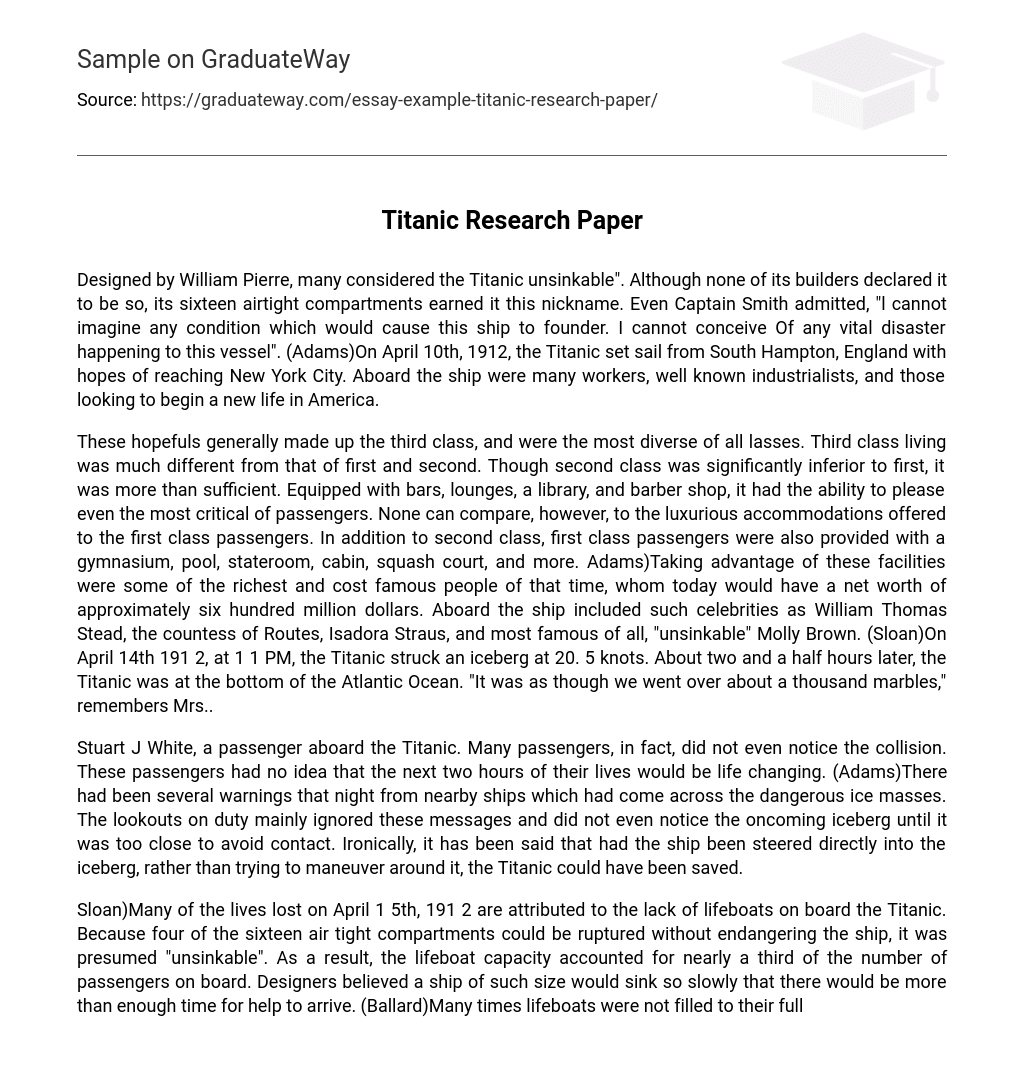Designed by William Pierre, many considered the Titanic unsinkable”. Although none of its builders declared it to be so, its sixteen airtight compartments earned it this nickname. Even Captain Smith admitted, “l cannot imagine any condition which would cause this ship to founder. I cannot conceive Of any vital disaster happening to this vessel”. (Adams)On April 10th, 1912, the Titanic set sail from South Hampton, England with hopes of reaching New York City. Aboard the ship were many workers, well known industrialists, and those looking to begin a new life in America.
These hopefuls generally made up the third class, and were the most diverse of all lasses. Third class living was much different from that of first and second. Though second class was significantly inferior to first, it was more than sufficient. Equipped with bars, lounges, a library, and barber shop, it had the ability to please even the most critical of passengers. None can compare, however, to the luxurious accommodations offered to the first class passengers. In addition to second class, first class passengers were also provided with a gymnasium, pool, stateroom, cabin, squash court, and more. Adams)Taking advantage of these facilities were some of the richest and cost famous people of that time, whom today would have a net worth of approximately six hundred million dollars. Aboard the ship included such celebrities as William Thomas Stead, the countess of Routes, Isadora Straus, and most famous of all, “unsinkable” Molly Brown. (Sloan)On April 14th 191 2, at 1 1 PM, the Titanic struck an iceberg at 20. 5 knots. About two and a half hours later, the Titanic was at the bottom of the Atlantic Ocean. “It was as though we went over about a thousand marbles,” remembers Mrs..
Stuart J White, a passenger aboard the Titanic. Many passengers, in fact, did not even notice the collision. These passengers had no idea that the next two hours of their lives would be life changing. (Adams)There had been several warnings that night from nearby ships which had come across the dangerous ice masses. The lookouts on duty mainly ignored these messages and did not even notice the oncoming iceberg until it was too close to avoid contact. Ironically, it has been said that had the ship been steered directly into the iceberg, rather than trying to maneuver around it, the Titanic could have been saved.
Sloan)Many of the lives lost on April 1 5th, 191 2 are attributed to the lack of lifeboats on board the Titanic. Because four of the sixteen air tight compartments could be ruptured without endangering the ship, it was presumed “unsinkable”. As a result, the lifeboat capacity accounted for nearly a third of the number of passengers on board. Designers believed a ship of such size would sink so slowly that there would be more than enough time for help to arrive. (Ballard)Many times lifeboats were not filled to their full capacity.
These lifeboats were built to hold forty men, and many times maintained as little as twelve passengers. Even those who had the option of taking advantage of lifeboat safety did not always choose to do so. Women and children were boarded onto the lifeboats first. Many, however, did not want to leave their fathers or husbands, and some simply refused to be lowered sixty-five feet into the water. When the wife of Isadora Straus was instructed to get on a lifeboat, she declared, “l will not be separated from my husband. As we have lived, so we will die together”.
One woman in particular would not give up such hope. (Adams)Molly Brown was born into a very lethal family, and was a passenger on the Titanic on her way to visit her sick grandchild. Molly was reading a book when she heard the crash, and wisely put on six pairs of wool stockings, a wool suit, fur coat, hat and muff. Molly Was placed in the sixth lifeboat and took charge by ordering all the Women to join her in rowing. Realizing that her boat was only half full, Molly insisted that they go back to rescue more passengers. She was appalled when her request was refused.
Later that night Molly boarded the Carpathians and helped in relief efforts. Molly not only calmed the foreign passengers with her knowledge of many languages, but raised ten thousand dollars to help the victims. In an interview, Molly regarded herself and her family as “unsinkable”, and the nickname appropriately stuck. (Figurate)The ARMS Carpathians was approximately fifty-eight miles away and arrived for help at 12:23 PM. One observer noted the strange calm of the night. “One thing stands out in my mind about it all, the quietness. There was no noise or hurry.
When our passengers at length came on deck they were some time before they seemed to realize the dependents nature of the tragedy; it was too big to assimilate at once. ” (Ballard)The effects of the Titanic are still present today. The ignorance to iceberg warnings and lack of lifeboat capacity has called for a new protocol concerning ships. Lookouts no longer have full authority, and ships must rely on new technologies to check for upcoming icebergs. At all times ships must maintain a twenty-four-hour radio watch in which the International Ice Patrol warns them of upcoming icebergs.





